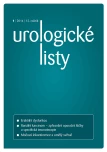Robotics in urology: getting started
Authors:
Z. Lee; S. S. Sehgal; D. I. Lee
Authors‘ workplace:
Perelman School of Medicine
; University of Pennsylvania School of Medicine
; Division of Urology
Published in:
Urol List 2014; 12(1): 32-36
Overview
Robot‑ assisted surgery has generated a great deal of excitement and enthusiasm in the urologic community, and its utilization continues to increase across many other specialties. The robotic modality maintains the benefits of minimally invasive surgery, while also providing three‑ dimensional vision, wristed instrumentation, and improved ergonomics for the surgeon. Establishing a robotics program is a process that requires careful consideration of the potential benefits and risks, and diligence in implementing a well thought‑ out plan. The purpose of this report is to highlight the key aspects of this process by focusing on preparation of the hospital, operating room, and practice.
Key words:
robotic surgery, training, education
Sources
1. Montorsi F, Wilson TG, Rosen RC et al. Best practices in robot‑ assisted radical prostatectomy: recommendations of the Pasadena Consensus Panel. Eur Urol 2012; 62(3): 368– 381. doi: 10.1016/ j.eururo.2012.05.057.
2. Menon M, Shrivastava A, Tewari A et al. Laparoscopic and robot assisted radical prostatectomy: establishment of a structured program and preliminary analysis of outcomes. J Urol 2002; 168(3): 945– 749.
3. Giulianotti PC, Coratti A, Angelini M et al. Robotics in general surgery: personal experience in a large community hospital. Arch Surg 2003; 138(7):777– 784.
4. Steers WD. Tips on establishing a robotics program in an academic setting. Scientific World Journal 2006; 17(6): 2531– 2541.
5. Hemal AK, Menon M. Robotics in urology. Curr Opin Urol 2004; 14(2): 89– 93.
6. Menon M, Hemal AK. Robotic urologic surgery: is this the way of the future? World J Urol 2006; 24(2): 119.
7. Babbar P, Hemal AK. Robot‑ assisted urologic surgery in 2010 – Advancements and future outlook. Urol Ann 2011; 3(1): 1– 7. doi: 10.4103/ 0974– 7796. 75853.
8. Menon M, Bhandari M, Gupta N et al. Biochemical recurrence following robot‑ assisted radical prostatectomy: analysis of 1384 patients with a median 5 year follow‑up. Eur Urol 2010; 58(6): 838– 846. doi: 10.1016/ j.eururo.2010.09.010.
9. Liss MA, Lusch A, Morales B et al. Robot‑ assisted radical prostatectomy: 5‑year oncological and biochemical outcomes. J Urol 2012; 188(6): 2205– 2210. doi: 10.1016/ j.juro.2012.08.009.
10. Suardi N, Ficarra V, Willemsen P et al. Long‑term biochemical recurrence rates after robot‑ assisted radical prostatectomy: analysis of a single‑center series of patients with a minimum follow‑up of 5 years. Urology 2012; 79(1): 133– 138. doi: 10.1016/ j.urology.2011.08.045.
11. Ahlering TE, Skarecky D, Lee D et al. Successful transfer of open surgical skills to a laparoscopic environment using a robotic interface: initial experience with laparoscopic radical prostatectomy. J Urol 2003; 170(5): 1738– 1741.
12. Lerner MA, Ayalew M, Peine WJ et al. Does training on a virtual reality robotic simulator improve performance on the da Vinci surgical system? J Endourol 2010; 24(3): 467– 472. doi: 10.1089/ end.2009.0190.
13. Perrenot C, Perez M, Tran N et al. The virtual reality simulator dV‑ Trainer(®) is a valid assessment tool for robotic surgical skills. Surg Endosc 2012; 26(9): 2587– 2593. doi: 10.1007/ s00464– 012– 2237– 0.
14. Steinberg PL, Merquerian PA, Bihrle W et al. A da Vinci robot system can make sense for a mature laparoscopic prostatectomy program. JSLS 2008; 12(1): 9– 12.
15. Bolenz C, Gupta A, Hotze T et al. Cost comparison of robotic, laparoscopic, and open radical prostatectomy for prostate cancer. Eur Urol 2010; 57(3): 453– 458. doi: 10.1016/ j.eururo.2009.11.008.
16. Lotan Y, Cadeddu JA, Gettman MT. The new economics of radical prostatectomy: cost comparison of open, laparoscopic and robot assisted techniques. J Urol 2004; 172(4 Pt 1): 1431– 1435.
17. Liberman D, Trinh QD, Jeldres C et al. Is robotic surgery cost‑effective: yes. Curr Opin Urol 2012; 22(1): 61– 65. doi: 10.1097/ MOU.0b013e32834d543f.
18. Close A, Robertson C, Rushton S et al. Comparative cost‑effectiveness of robot‑ assisted and standard laparoscopic prostatectomy as alternatives to open radical prostatectomy for treatment of men with localised prostate cancer: a health technology assessment from the perspective of the UK National Health Service. Eur Urol 2013; 64(3): 361– 369. doi: 10.1016/ j.eururo.2013.02.040.
19. Herron DM, Marohn M. A consensus document on robotic surgery. Surg Endosc 2008; 22(2): 313– 325.
20. Zorn KC, Gautam G, Shalhav AL et al. Training, credentialing, proctoring and medicolegal risksof robotic urological surgery: recommendations of the society of urologic robotic surgeons. J Urol 2009; 182(3): 1126– 1132. doi: 10.1016/ j.juro.2009.05.042.
21. Menon M, Tewari A. Robotic radical prostatectomy and the Vattikuti Urology Institute technique: an interim analysis of results and technical points. Urology 2003; 61 (4 Suppl 1): 15– 20.
22. Menon M, Tewari A, Baize B et al. Prospective comparison of radical retropubic prostatectomy and robot‑ assisted anatomic prostatectomy: the Vattikuti Urology Institute experience. Urology 2002; 60(5): 864– 868.
23. Lee DI, Eichel L, Skarecky DW et al. Robotic laparoscopic radical prostatectomy with a single assistant. Urology 2004; 63(6): 1172– 1175.
Labels
Paediatric urologist UrologyArticle was published in
Urological Journal

2014 Issue 1
Most read in this issue
- A practical approach to treating voiding dysfunctions in men and women
- Possibilities of surgical treatment of erectile DYSFUNCTION – development and current possibilities
- Development of medicamentous therapy of ED – past, present and future
- Pathophysiology of erectile dysfunction
